What was the Aegis?
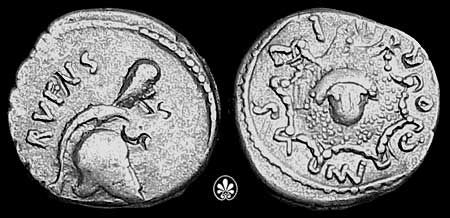
Roman Republican denarius of moneyer Manius Cordius Rufus
In Greek myth the hero Perseus kept the head of the gorgon Medusa in a special bag. He used the head on many adventures. In the Apollodorus (1st century AD) version of the myth Perseus used the head to turn king Polydectes and his friends to stone. He gives the gorgon head to Athena, and Hermes inserts the head in the middle of her shield.
In The Iliad (750-725 BC) Homer says that the gorgon's likeness appears on the aegis of Athena. Homer probably wasn't talking about a shield because he also says the gorgon's likeness appears on Agamemnon's shield. Homer also says the aegis is the thundercloud of Zeus.
Herodotus wrote (450-430 BC) that the aegis was a tasseled goatskin worn by Libyan women and that Zeus had such a skin made from the goat that suckled him. Dionysius Scytobrachion said that the Aegis was a fire breathing monster that Athena killed and skinned.
Mythology was full of conflicting stories. Different ancient people would have had different ideas about the aegis. We only have a few versions of the stories that survived. The ancients would have had more conflicting versions, not a single version that was written down incorrectly a few times. Other myths claim that Perseus didn't even give the gorgon's head to Athena. Pausanias says it's buried in an earthen mound near the Argos market. Another story (whose?) says it was brought to Iconium.
The Romans loved the image of the aegis and wore gorgoneions on their ceremonial armor on coins. For more information on the aegis with many pictures of aegis-style clothing depicted on coins see John W. Bitner's article in The Celator, June 1999.
This page is about coins where the aegis is the main device on a coin.
![[coin image]](aegis/81q.jpg) The aegis was sometimes used on coins in the second and first centuries BC. Before this time the gorgon image alone was popular, but we rarely see it in an aegis. (The aegis is known behind Medusa on a rare gold obol of Syracuse. It is also seen around Athena on didrachm of Heraclea and litra of Tarentum.) No coins of Apollonia Pontika have been described as having an aegis. The vague outline of an aegis can be seen behind the gorgon. I've found five coins with this feature offered on eBay during summer-fall 2002. I believe all all are from a recent hoard. I haven't been able to find any coins with this feature in the published literature. The five aegis coins come from four obverse dies but only two reverse dies.
The aegis was sometimes used on coins in the second and first centuries BC. Before this time the gorgon image alone was popular, but we rarely see it in an aegis. (The aegis is known behind Medusa on a rare gold obol of Syracuse. It is also seen around Athena on didrachm of Heraclea and litra of Tarentum.) No coins of Apollonia Pontika have been described as having an aegis. The vague outline of an aegis can be seen behind the gorgon. I've found five coins with this feature offered on eBay during summer-fall 2002. I believe all all are from a recent hoard. I haven't been able to find any coins with this feature in the published literature. The five aegis coins come from four obverse dies but only two reverse dies.
Compare to this speciment from the same reverse die.
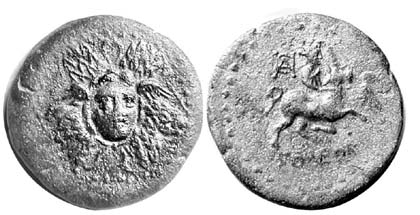 This coin comes from Soloi in Cilicia. It's dated to the 3rd or second century BC, making it possible the oldest bronze coin with an aegis I know of. The reverse features Aphrodite riding on a bull. The coins have a border of dots around the type on both sides, but the dot border is not part of the aegis. There is a ragged line around the aegis which is difficult to see in this photo. It borders the 'tassles' and makes the aegis seem loose, like a cloth or skin.
This coin comes from Soloi in Cilicia. It's dated to the 3rd or second century BC, making it possible the oldest bronze coin with an aegis I know of. The reverse features Aphrodite riding on a bull. The coins have a border of dots around the type on both sides, but the dot border is not part of the aegis. There is a ragged line around the aegis which is difficult to see in this photo. It borders the 'tassles' and makes the aegis seem loose, like a cloth or skin.
The most common aegis type is a bronze from Pontos struck during the reign of Mithradates VI ("the Great"). Mithradates used Perseus, Pegasos, and the Aegis on his coins to emphasize that he was a Persian king and thus a descendent of Perseus. The Aegis type is known in bronze for six cities.
Many coins of this type have monograms and symbols on the reverse. These coins are usually found quite worn and with filing marks. The wear is often hard to see in photographs.
Usually the aegis on Pontos coins has eight sides, but sometimes six. The corners seem to have various hooks and fasteners. It's not clear (to me) if this was to fasten the aegis to something or if the sides were rigid to keep it spread out for display without being attached to anything. Usually the border segments are straight or bow inward. Sometimes they bow outward or are made of dots (like the Rufus denarius) rather than lines.
I feel the hooks and fasteners show the engravers were trying to depict something they had actually seen. They were not working off their imagination of how Athena's mythical shield would have looked.
These Pontos bronzes were so popular that imitations of them were even struck. They were also used as blanks for other coins. The first coin is a crude, cartoonish Sarmatian issue. For another example of this type, see coins and history of Asia [Black Sea].) Note how the legend on this coin has degenerated to just 'W-Σ'. Two more can be seen in Mitchiner's Ancient and Classical World.
The second coin is from Pantikapaion. An aegis/Nike type was used as a blank. This was apparently a common, another example of the same Pantikapaion coin struck on a Pontos blank can be seen in SNG Black Sea (#939.) The Pantikapaion type was struck c. 100-75 BC and the Pontos type was struck c. 85-60 BC. Thus, this overstrike would have been made c. 85-75 BC.
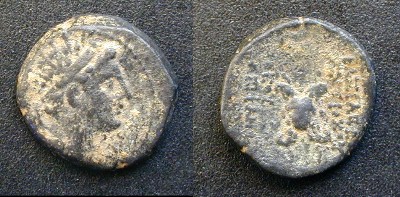 This coin was struck by the Seleucid king Antiochos IV (175-164 BC). In the 2nd century AD Pausanias wrote (Description of Greece, 5.12.4) "In Olympia there is a woollen curtain, adorned with Assyrian weaving and Phoenician purple, which was dedicated by Antiochus [probably IV], who also gave as offerings the golden aegis with the Gorgon on it above the theater at Athens." It's been suggested the aegis shown here may represent that one. This aegis has four sides and is shaped like the letter X.
This coin was struck by the Seleucid king Antiochos IV (175-164 BC). In the 2nd century AD Pausanias wrote (Description of Greece, 5.12.4) "In Olympia there is a woollen curtain, adorned with Assyrian weaving and Phoenician purple, which was dedicated by Antiochus [probably IV], who also gave as offerings the golden aegis with the Gorgon on it above the theater at Athens." It's been suggested the aegis shown here may represent that one. This aegis has four sides and is shaped like the letter X.
 The Roman moneyer Manius Cordius Rufus issued an aegis denarius in 46BC. The obverse depicts an owl on a Corinthian helmet. (This example also depicts banker's marks on the helmet.) The aegis has nine sides on this example, but I've also seen eight. For more coins of this moneyer see his thumbnail page on Wildwinds.com.
The Roman moneyer Manius Cordius Rufus issued an aegis denarius in 46BC. The obverse depicts an owl on a Corinthian helmet. (This example also depicts banker's marks on the helmet.) The aegis has nine sides on this example, but I've also seen eight. For more coins of this moneyer see his thumbnail page on Wildwinds.com.
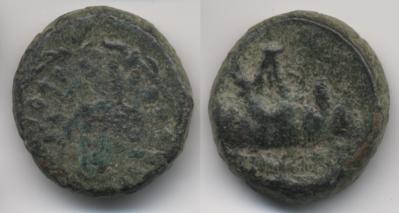 The most recent example of the type that I know of comes from Cappadocia; the city of Caesarea (also known as Eusebeia). The reverse shows Mount Argaios. Argaios (also spelled Argaeus and Argeus) is a 12,850' high volcano, today called Erciyas. It was personified and the center of a cult. This type is listed as being struck sometime during the period 36BC - 17AD. A somewhat better example of this coin can be seen in Lingren III 945.
The most recent example of the type that I know of comes from Cappadocia; the city of Caesarea (also known as Eusebeia). The reverse shows Mount Argaios. Argaios (also spelled Argaeus and Argeus) is a 12,850' high volcano, today called Erciyas. It was personified and the center of a cult. This type is listed as being struck sometime during the period 36BC - 17AD. A somewhat better example of this coin can be seen in Lingren III 945.
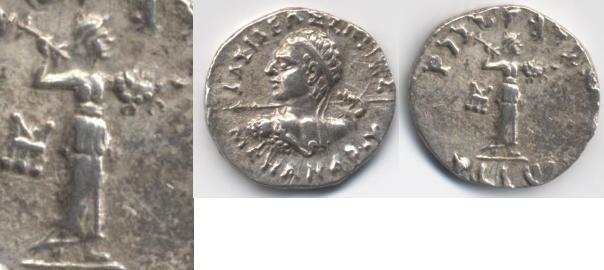 Here is Athena holding a lighting bolt with an aegis on her other arm. This image is taken from a Bactrian coin showing the Buddhist king Menander in heroic pose wearing aegis-derived clothing on the other side.
Here is Athena holding a lighting bolt with an aegis on her other arm. This image is taken from a Bactrian coin showing the Buddhist king Menander in heroic pose wearing aegis-derived clothing on the other side.
It's clear that Athena is throwing the lighting bolt. It's not clear to me what she is doing with the aegis on her other arm.
Why does Athena drape the aegis over her arm? It doesn't seem to protect her arm. If the visual appearance of the aegis is important, why does she make it hard to see? The lightening in the other hand is interesting. In mythology the aegis was originally associated with Zeus. Lightening was also a trait of Zeus.
I'm not convinced the aegis was any one particular thing. Perhaps even the ancient artists didn't know what it was and depicted the aegis using theatrical props and other images of the aegis as guides?
The aegis used on the coins of Mithradates and the Roman denarius look, with their hooks and sticks, look like they need to be attached to something. Perhaps they are military in nature? They remind me of pirate flags, the 'skull and crossbones.'
Why does Athena hold the aegis in that way when she is throwing lightening? Is it related to thunder? Could the tassles have made the sound of rain somehow?
I've looked at aegis-bearing coins for over a year and I have no real idea what was meant by them or why artists drew them the way they did. They certainly are a horrifying and bizarre image to put on the coins that folks would use in daily commerce. What did ancient rulers hope to acheive by putting this image on coins? Perhaps no one will ever know.
Thanks to the following dealers for selling me these coins:
Ancient Auction House,
Ancient Treasures,
Antioch Associates,
Harlan J. Berk,
Guy Clark,
Classical Numismatic Group,
Colosseum Coin Exchange
Jean Elsen,
Tamco,
Mediterrean Coins,
and Oliver Hoover.
Numismatic references:
Sylloge Nummorum Graecorum The British Museum, I The Black Sea British Museum Press, 1993.
(SNG Black Sea)
Ancient bronze coins of Asia Minor and the Levant. by Lindgren & Kovacs, 1985.
Lindgren III : Ancient Greek bronze coins from the Lindgren collection by Henry Clay Lindgren, 1993.
Greek coins and their values. Vol. II. Asia and North Africa by David Sear. 1979. (Sear GCV)
The ancient & classical world, 600 B.C. - A.D. 650 : Oriental coins and their values. by Michael Mitchiner, 1978.